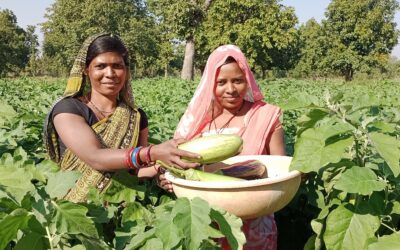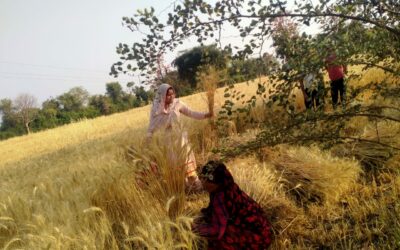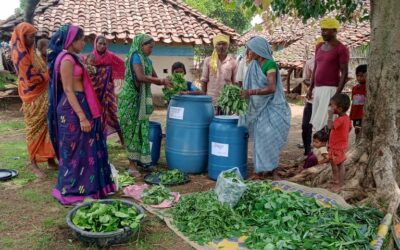Crop production is vulnerable to various abiotic and biotic stresses that are made more adverse by climate change factors. Improved agronomic practices and cultivation of stress tolerant varieties can sustain production in changing climatic condition. System of Millet Intensification is one such approach which resulted in higher production in finger millet, contributing to the food and nutritional security of the tribal households in Koraput, even under extreme weather conditions.
Finger millet is a major staple food crop, second only to paddy, among subsistence farming households in the rainfed uplands of Koraput district in South Odisha. While it is traditionally cultivated for food security, it also provides them with much needed nutritional security too. Finger millet is a sturdy crop, resilient to a variety of agro-climatic adversities, such as poor soil fertility and drought conditions, and it requires low inputs. Also, the crop provides a hardy ecosystem, with little or no need for external plant protection measures. Finger millet seeds can resist storage pests for as long as 10 years, ensuring year-round food supply, even during a crop failure. This has earned it the name of ‘famine crop’
The tribal farmers of Koraput cultivate finger millet in the uplands as a sole crop and also as a mixed crop with other minor millets, pulses, maize and oil seeds. Farmers generally follow seed broadcasting method. Broadcasting results in inefficient use of moisture and nutrients, resulting in low yield. Less attention is given to timely weeding, pest and nutrition management. The yield is generally 3-4 qts/ha in broad casting method and 8-9 qtls/ha in traditional transplanting method. Farmers maintain local cultivars by continuously selecting seeds suitable to local agro-ecosystem. However, presently only three varieties of finger millets (Bada Mandia, Kala Mandia, and Bhairabi)are mostly cultivated. Among them, the Bada Mandia being most productive, dominates. Access to quality seeds and storage continue to be major constraints. All these factors have threatened not only the millet eco-system but also accelerated loss of their genetic diversity and the traditional food culture associated with them.
After years of declining interest and support, finger millet, of late, is finding demand in urban food markets. This article highlights the experience of Pragati-Koraput, an NGO, in reviving finger millet among small holder farmers under the rainfed farming systems in Koraput district in South Odisha. The programme objective is to enhance production from small farms through system of crop intensification.
System of Finger Millet Intensification (SMI) – An agro ecological innovation
Agro-ecological approaches like System of Rice Intensification aims to produce crops more efficiently and sustainably by depending more on endogenous processes than on external inputs. With the success of promotion of SRI from 2008, Pragati promoted the principles of crop intensification in ragi too.
In 2011, Pragati organised a demonstration of SMI in Raising village of Nandapur block. Initially farmers were skeptical in following the practice. After rounds of discussion, eleven farmers adopted SMI in 0.5 acres of land each, with the condition that, Pragati will provide compensation in case of yield loss. SMI practices included raising nursery, transplanting young seedlings, weeding by weeders and application of organic manures.
Seven varieties of indigenous seeds were promoted. Farmers were trained on seed selection, conservation and seed multiplication. Quality seeds are now preserved by farmers both at individual level and also in community seed banks.
The result of the trial was striking to the farmers as there were 12- 18 tillers on an average and the best field of one farmer had 44-47 tillers per plant hill. The average yield was 18 quintal/ha, the highest being 26 quintal/ha. A field day was organised to disseminate the result to the farmers, in which the officials of agriculture department also participated.
Spread
The average yield in SMI was 12-14 quintals per hectare which was more than double than the average yields from traditional method. This was a substantial motivating factor for farmers to adopt SMI, though initially farmers were skeptical that SMI is labour intensive. Video disseminations, wall paintings, posters, field support by community resource persons, farmers’ fairs, field days and felicitation of the farmers are some of the methods that Pragati used for upscaling SMI.
Instead of pushing a set package of practices, Pragati has been encouraging farmer innovations. Farmers are being motivated to try new methods, make adaptations to local conditions and practice based on their own assessment. For example, when the soil gets hard and is difficult to use a weeder, farmers resort to manual hoeing and ploughing by tying the mouth of bullocks. Pulling a wooden leveller on the plants after weeding is a farmer’s innovation that leads to profuse tillering and enhanced yield.
In 2014, SMI fields could survive the hazards
of the cyclone Hudhud which occurred during
the month of October, whereas the finger
millet grown in traditional method lodged and
got damaged by the wind.
All these efforts resulted in farmers taking up SMI on a large scale. Till Kharif 2017, the practice of SMI has spread to 3518 farmers in 215 villages covering 927 hectares of land in Nandapur, Lamtaput and Kotpad blocks.
Impact
It was observed that crops were more tolerant to erratic monsoon and drought like situations where SMI was adopted. Farmers could harvest on an average 12-14 qts /ha, in spite of irregular monsoon and drought like situations in 2012 and 2013. In 2014, SMI fields could survive the hazards of the cyclone Hudhud which occurred during the month of October, while the crop grown in traditional method lodged and got damaged by the wind. Dayanidhi Khara of Maliput village in Nandapur block says “Most of the paddy and finger millet crops were lodged due to heavy winds, but my robust finger millet plants grown in SMI method could survive fury of the cyclone in 2014. My family had enough harvest for consumption.”
As transplanting facilitates inter-row and interplant weed control, farmers used weeding tools like roller weeder to incorporate the weeds into the soil, boosting fertility. Aerating the soil stimulated the growth of plant roots, making them strong enough to resist heavy winds. Also with the use of roller weeders, men started sharing responsibilities in weeding. Dependence on hired labour got reduced.
Harvesting became much easier as plant growth is more uniform and the mature fingers do not get entangled. The women found it easier to harvest the fingers in SMI field. They could complete the task in half the time as compared to time required in a traditional broadcasted field. Thus, there was less drudgery for women.
Increase in production has significantly contributed to the nutritional food security of a very vulnerable community, with small land holdings. For the farmers adopting SMI, there is now enough millet available for household consumption for the whole year. The yield increase has also generated surplus for sale. As the potential of finger millet market is expanding, the price has increased from Rs 5-7/per kg in 2009 to Rs 22-25/per kg in 2017, thus ensuring better incomes.
| Box 1: SMI Practices Around 400- 500 gm. of seed is required per acre. Seed selection is done through brine water solution. Seed treatment is done by medicinal pot manure/Bijamrita. Micro-organisms and nutrients are added to make the seedlings more vigorous, resistant to pests and diseases.
Raised seed bed is prepared by mixing soil and compost in 2:1 ratio. The seeds are put into the nursery soil at a depth of 1/2 inch, with spacing about 3 to 4 inches between the seeds. 15 kg of vermi-compost/powdered FYM is spread over the bed in a thin layer and covered with straw. Then the seed bed is watered once in a day.15 days seedlings become ready for transplantation. The land is ploughed thoroughly 2 to 3 times within an interval of 8-10 days. Compost and Neem/Karanja cake are applied during land preparation. After ploughing, the field is leveled using a wooden leveler. Seedlings are transplanted from the nursery into the main field when they are only 15-18 days old, with mass of soil attached to the root and there is moisture in the field. The spacing is maintained at 25 x 25 cm using a rope marker. Farmyard manure and vermi compost are applied in the pits at the time of planting. First weeding is done within 15- 20 days after transplanting with a roller weeder or cycle hoe. Second and third weeding is done either by roller weeder or manually by hoeing as the soil is hard (due to the upland). Vermi compost, pot manure or Jibamruta solution is applied after each weeding. In order to control pests, medicinal pot manure or neem oil solution is sprayed. |
Way forward
SMI is emerging as a solution not only to reduce the hunger gap, but also as an agro-ecological approach to address climate change conditions. High productivity, tolerance to climate adversities and reduction in drudgery for women are some of the contributing factors for the upscaling of SMI. However, scaling up is not devoid of challenges. As the production increases substantially in SMI, one of the major challenges is primary processing i.e. dehusking and cleaning, which is a time consuming and tedious task for women. There are no primary processing units for millets in the production clusters. The problem of storage is also felt as the farmers do not have adequate space to keep their produce. This may also lead to distress sale to the middlemen in the value chain. It is therefore important to address these challenges, some of which include – organizing farmers, building collaboration with Government and appropriate policy support.
Acknowledgments
Pragati Koraput gratefully acknowledges the cooperation and the innovative efforts of the small and marginal farmers who demonstrate the technology in their respective fields. We are thankful to Trocaire, SDTT, Government of India and Government of Odisha under the Special Programme for Promotion of Millets in Tribal Areas of Odisha. We are thankful to Digital Green for giving us the technology for extension through production and dissemination of farmer friendly videos.
Luna Panda
Executive Director
Muralidhar Adhikari
Team Leader
Pragati Koraput, Pujariput, Koraput- 764020
Odisha
E-mail : pragatikoraput@gmail.com
www.pragatikoraput.org









